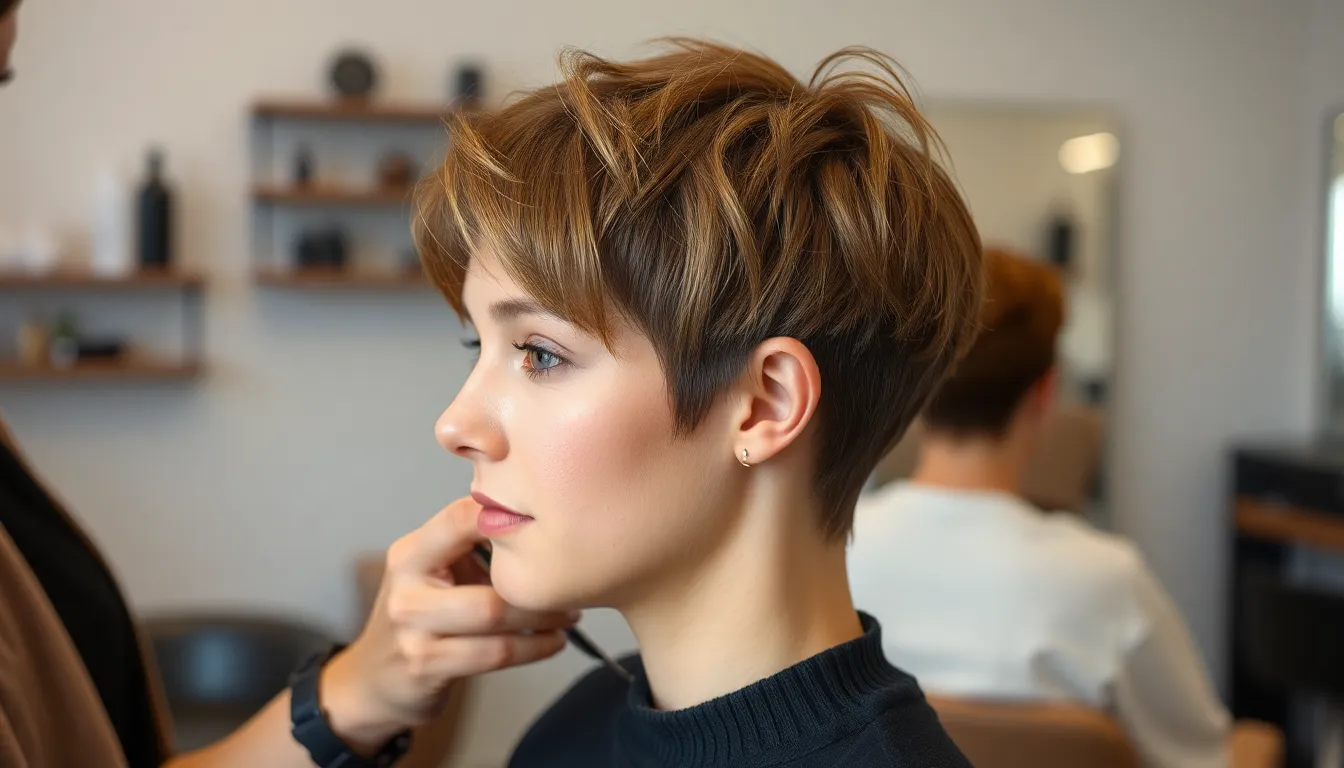We’re about to jump into one of the most daring and versatile short hairstyles that’s taking the beauty industry by storm. Choppy pixie cuts offer the perfect blend of edgy sophistication and effortless style that works for virtually every face shape and hair texture.
What makes choppy pixie cuts so irresistible? The strategic layers and textured ends create incredible movement and volume while maintaining that chic, low-maintenance appeal we all crave. Whether you’re looking to make a bold statement or simply want a fresh new look that saves time on your morning routine, this cut delivers both style and practicality.
From subtle texture to dramatically jagged layers, choppy pixie cuts can be customized to match your personality and lifestyle. We’ll explore everything you need to know about this groundbreaking hairstyle, from choosing the right variation for your features to styling tips that’ll keep you looking effortlessly polished every day.
Understanding The Choppy Pixie Cut Style
Now that we’ve explored the appeal of choppy pixie cuts, let’s dive deeper into what makes this hairstyle so distinctive and versatile.
Definition And Key Characteristics
Choppy pixie cuts feature strategically placed uneven layers that create texture and movement throughout the hair. These cuts typically maintain shorter lengths on the sides and back while leaving slightly longer pieces on top for styling versatility. We see deliberate disconnection between hair sections that produces an edgy, lived-in appearance.
Textured ends define the choppy pixie’s signature look. Rather than blunt cuts, stylists use point cutting and razor techniques to create jagged, uneven endings. This approach adds visual interest and prevents the hair from appearing flat or one-dimensional.
Volume and dimension characterize well-executed choppy pixie cuts. The varying layer lengths allow hair to stack and separate naturally, creating fullness even in fine hair types. We notice how the choppy technique eliminates weight from certain areas while maintaining body in others.
Face-framing elements enhance the overall style’s flattering qualities. Longer pieces around the ears and temples can be customized to complement exact facial features. These strategic lengths soften harsh angles or add structure where needed.
Difference Between Classic And Choppy Pixie Cuts
Classic pixie cuts maintain uniform lengths with smooth, polished finishes throughout. Traditional versions feature clean lines and even layers that create a neat, structured appearance. We observe how classic cuts rely on precision and symmetry for their sophisticated appeal.
Choppy pixie variations embrace intentional irregularity and texture. Unlike their classic counterparts, choppy cuts incorporate deliberate imperfections and varying lengths. The styling creates controlled chaos that appears effortlessly tousled rather than perfectly groomed.
Maintenance requirements differ significantly between the two styles. Classic pixies demand regular trims every 4-6 weeks to maintain their sharp, defined shape. Choppy versions can grow out more gracefully, often looking better as they settle and develop natural texture.
Styling versatility varies considerably between classic and choppy approaches. Traditional pixie cuts typically require exact styling products and techniques to achieve their intended look. Choppy cuts adapt to multiple styling methods, from sleek and smooth to tousled and messy, offering greater day-to-day flexibility.
Benefits Of Choosing Choppy Pixie Cuts

Choppy pixie cuts offer remarkable advantages that extend far beyond their striking appearance. We’ve identified three key benefits that make this hairstyle choice particularly appealing for modern women seeking both style and practicality.
Low Maintenance Styling Requirements
Daily styling becomes effortless with choppy pixie cuts due to their naturally tousled texture. We recommend using a small amount of texturizing cream or sea salt spray on damp hair, then scrunching gently with your fingers for instant definition.
Morning routines shrink dramatically when you choose this cut, typically requiring only 5-10 minutes of styling time. The intentional irregularity means you don’t need perfect placement of every strand, making rushed mornings much more manageable.
Product usage decreases significantly compared to longer hairstyles, saving both time and money. We suggest investing in just 2-3 quality products: a lightweight styling cream, dry shampoo, and optional finishing spray for special occasions.
Wash frequency can be reduced to every 2-3 days since the textured layers disguise natural oils effectively. This benefit particularly appeals to busy professionals and active individuals who want to minimize hair care time.
Enhanced Facial Feature Definition
Cheekbones become more prominent when choppy layers frame the face at strategic angles. We’ve observed that shorter sides create natural highlighting effects that enhance bone structure without requiring contouring makeup.
Eye focus intensifies dramatically as the absence of longer hair draws attention upward to your most expressive features. The choppy texture adds visual interest around the eye area, making them appear larger and more defined.
Jawline definition improves significantly through carefully placed layers that can either soften square faces or add structure to round faces. We customize the choppy placement to complement each individual’s facial geometry.
Neck elongation occurs naturally when hair sits close to the head, creating a graceful silhouette that enhances overall proportions. This effect proves especially flattering for those with shorter necks or fuller face shapes.
Versatile Texture And Movement
Styling options multiply exponentially even though the shorter length, allowing for sleek, tousled, or deliberately messy looks depending on your mood. We can achieve completely different appearances using various styling techniques and products.
Movement increases throughout the day as choppy layers naturally shift and settle into attractive positions. Unlike blunt cuts that maintain static shapes, these cuts evolve beautifully from morning to evening.
Volume appears instantly due to the strategic layering that prevents hair from lying flat against the scalp. We’ve found that even fine hair types gain substantial body and dimension with proper choppy pixie cutting techniques.
Adaptability extends across seasons and occasions, from professional settings to casual weekends. The inherent texture allows for both polished corporate looks and effortless weekend styles without requiring different cuts.
Popular Choppy Pixie Cut Variations

These distinctive choppy pixie variations offer unique styling possibilities that transform the basic cut into personalized statements of modern hair fashion.
Asymmetrical Choppy Pixie
Asymmetrical choppy pixies feature dramatically different lengths on each side, creating bold visual interest through intentional imbalance. One side typically measures 2-3 inches longer than the other, allowing for versatile styling options that can be tucked behind the ear or swept across the forehead.
Strategic placement of choppy layers enhances the asymmetrical effect, with shorter pieces concentrated on one side and longer textured sections flowing toward the opposite direction. This variation works exceptionally well for oval and heart-shaped faces, as the uneven lengths soften angular features while maintaining the edgy appeal.
Styling flexibility makes this cut perfect for professional environments and casual settings alike. We can slick down the shorter side with styling gel for a polished business look, or tousle the longer pieces with texturizing spray for weekend adventures.
Layered Choppy Pixie With Side Bangs
Layered choppy pixies with side bangs combine multiple texturizing techniques to create maximum movement and dimension throughout the cut. The side-swept fringe typically measures 3-4 inches in length, blending seamlessly into the choppy layers around the crown and temples.
Graduated layers start shorter at the nape and progressively lengthen toward the front, creating natural volume that lifts away from the scalp. This technique prevents the flat appearance common in traditional pixie cuts while maintaining the sophisticated silhouette.
Face-framing benefits make this variation ideal for square and round face shapes, as the diagonal sweep of bangs creates vertical lines that elongate facial features. The choppy texture in both the bangs and layers adds softness to strong jawlines and cheekbones.
Textured Choppy Pixie With Undercut
Textured choppy pixies with undercuts feature closely cropped sides measuring 1/8 to 1/4 inch, creating dramatic contrast with the longer textured pieces on top. This variation offers the most dramatic interpretation of the choppy pixie trend.
Razor cutting techniques throughout the crown section create maximum texture and movement, while the clean undercut provides sharp definition around the ears and neckline. The contrast between textures adds visual depth that works well with both fine and thick hair types.
Maintenance requirements for this variation include professional touch-ups every 4-6 weeks to keep the undercut crisp and the choppy layers properly shaped. We recommend using lightweight pomade on damp hair to enhance the textured pieces while keeping the undercut sections smooth and defined.
Face Shapes That Suit Choppy Pixie Cuts

Understanding which face shapes work best with choppy pixie cuts helps ensure you’ll love your new look. We’ll explore the most compatible face shapes and provide targeted styling guidance for each.
Oval Face Shape Compatibility
Oval faces benefit from the universal appeal of choppy pixie cuts, as this balanced facial structure complements virtually any variation. We recommend emphasizing the natural symmetry by keeping layers evenly distributed throughout the cut. Texturing works particularly well around the crown area, creating volume that enhances the oval shape’s inherent proportions.
Adding choppy layers near the temples draws attention to your eyes while maintaining facial harmony. Styling options remain limitless with this face shape, from sleek side swept looks to tousled textured finishes. Consider incorporating subtle asymmetrical elements to add visual interest without overwhelming your balanced features.
Heart-Shaped Face Considerations
Heart shaped faces pair beautifully with choppy pixie cuts that focus texture around the jawline and chin area. We suggest requesting longer choppy pieces near the ears to create width in the lower portion of your face. Avoiding excessive volume at the crown prevents emphasizing the broader forehead typical of this face shape.
Side swept choppy bangs work exceptionally well for heart shaped faces, softening angular features while adding movement. Texturing should concentrate on the mid lengths rather than the very top layers. Creating subtle fullness around the jaw area helps balance the narrower chin with the wider forehead dimensions.
Square Face Styling Tips
Square faces benefit from choppy pixie cuts that soften strong jawlines through strategic layering and texture placement. We recommend incorporating wispy, textured pieces around the face to break up angular features. Avoiding blunt cuts at jaw level prevents emphasizing the square shape’s inherent width.
Creating height through choppy crown layers helps elongate the appearance of square faces. Texturing should focus on adding movement rather than structured lines that might enhance angular features. Consider incorporating longer choppy bangs that can be styled to one side, creating diagonal lines that counteract the square shape’s geometric appearance.
Hair Texture Compatibility For Choppy Pixie Cuts

Different hair textures require exact approaches to achieve the perfect choppy pixie cut that complements your natural characteristics. We’ll explore how to adapt this versatile style for fine, thick, and curly hair types to maximize both appearance and manageability.
Fine Hair Styling Techniques
Fine hair benefits significantly from choppy pixie cuts because the textured layers create an illusion of fuller, thicker strands. Strategic razor cutting techniques add essential grip and movement that fine hair naturally lacks.
Layering fine hair at different lengths prevents the flat appearance that often plagues thin textures. Point cutting creates microscopic variations in length that catch light differently and enhance visual volume.
Volumizing products work best when applied to damp fine hair before cutting:
| Product Type | Application Method | Expected Result |
|---|---|---|
| Root lifting spray | Apply to damp roots | 30-40% volume increase |
| Texturizing mousse | Distribute through mid-lengths | Enhanced grip and hold |
| Sea salt spray | Mist on towel-dried hair | Natural texture and body |
Shorter choppy layers around the crown area provide maximum lift for fine hair textures. We recommend keeping the longest pieces no more than 2-3 inches to maintain structural integrity and prevent weighing down.
Thick Hair Management Methods
Thick hair requires strategic thinning techniques to prevent choppy pixie cuts from appearing bulky or overwhelming. Professional thinning shears remove excess weight while maintaining the desired choppy texture throughout.
Razoring thick hair creates softer, more blended transitions between choppy layers. This technique reduces bulk without sacrificing the edgy characteristics that define this cut style.
Weight removal focuses on these exact areas for thick hair:
- Interior layers need 40-50% bulk reduction
- Perimeter sections require subtle texturizing only
- Crown areas benefit from deeper layering techniques
- Nape regions should maintain some weight for balance
Graduated layering works exceptionally well for managing thick hair in choppy pixie cuts. Each layer removes progressively more weight as it moves toward the interior of the cut.
Curly Hair Adaptation Strategies
Curly hair naturally creates texture and movement that enhances choppy pixie cut characteristics. The key lies in working with your curl pattern rather than fighting against its natural tendencies.
Dry cutting techniques prove most effective for curly hair because stylists can see exactly how each curl falls and reacts. We recommend cutting curls in their natural state to achieve the most flattering choppy layers.
Curl-exact choppy pixie techniques include:
- Cutting each curl individually to maintain shape
- Creating longer layers on top for curl definition
- Removing weight from underneath to prevent triangular shapes
- Leaving perimeter pieces slightly longer for movement
Spring factor calculations help determine proper length for curly choppy pixie cuts. Most curls shrink 25-50% when dry, so stylists must account for this natural contraction during cutting.
Moisture retention becomes crucial for curly choppy pixie cuts because shorter lengths can lead to faster moisture loss. Leave-in conditioners and curl-defining creams help maintain healthy curl patterns while improving the choppy texture.
Essential Styling Products For Choppy Pixie Cuts

Choppy pixie cuts reach their full potential when paired with the right styling products that enhance texture and maintain that effortlessly tousled look. We’ll explore the must-have products that work specifically with the layered, textured nature of these cuts.
Texturizing Sprays And Mousses
Texturizing sprays create instant volume and grip for choppy pixie cuts while maintaining that piecey, separated look we love. We recommend applying sea salt sprays like Bumble and Bumble Surf Spray or Not Your Mother’s Beach Babe Texturizing Sea Salt Spray to damp hair before styling. These products work by adding mineral content that roughens the hair cuticle and creates natural hold without stiffness.
Volumizing mousses build lift at the roots where choppy pixie cuts need the most support. We suggest using lightweight formulas such as Ouai Wave Spray or Living Proof Full Thickening Mousse on towel dried hair. Apply these products by scrunching them through the mid lengths and ends while avoiding the scalp area to prevent weighing down fine hair textures.
Dry texturizing sprays refresh second day styles and add grit to freshly washed hair that might be too soft to hold texture. Products like Oribe Dry Texturizing Spray or Batiste Texture Me Texturizing Spray work best when sprayed 6 8 inches away from the head in short bursts.
Pomades And Styling Waxes
Pomades provide flexible hold and subtle shine that works perfectly with the intentionally messy nature of choppy pixie cuts. We prefer water based pomades like American Crew Pomade or Suavecito Original Hold Pomade because they wash out easily and don’t build up over time. These products work best when warmed between the palms and worked through dry or slightly damp hair.
Styling waxes offer stronger hold with a matte finish for those who want more definition in their choppy layers. We recommend using small amounts of products like Redken Wax Blast 10 or Bed Head by TIGI Matte Separation Workable Wax. Start with a pea sized amount and add more as needed since these products can quickly become heavy on short hair.
Clay based styling products create natural looking texture while absorbing excess oils that can weigh down choppy pixie cuts. We suggest trying Hanz de Fuko Claymation or Baxter of California Clay Pomade for a lived in finish that enhances the cut’s natural movement. These products work particularly well on thick or coarse hair textures that need extra control.
Heat Protectant Products
Heat protectant sprays safeguard choppy pixie cuts from the daily styling tools we use to enhance their texture. We always apply products like TRESemmé Thermal Creations Heat Tamer Spray or Moroccanoil Heat Styling Protection to damp hair before blow drying or using flat irons. These formulas create an invisible barrier that prevents heat damage up to 450°F while adding lightweight moisture.
Leave in treatments with heat protection serve double duty by nourishing the shorter lengths while protecting from styling damage. We recommend using It’s a 10 Miracle Leave In Product or Olaplex No. 6 Bond Smoother on the ends and mid lengths where choppy cuts tend to be most fragile. These products also help seal split ends that can make textured cuts look frizzy rather than intentionally messy.
Thermal protectant creams work best for thicker hair textures that need extra moisture and heat defense. We suggest applying products like Living Proof Restore Perfecting Spray or Kerastase Keratine Thermique to towel dried hair before any heat styling. These richer formulas provide deeper protection while smoothing the hair cuticle for better light reflection and shine.
Daily Styling Methods For Choppy Pixie Cuts

Mastering daily styling techniques transforms your choppy pixie cut from bedhead to runway ready. These proven methods work perfectly with the textured layers we’ve explored while maintaining the effortless movement that makes choppy pixies so appealing.
Quick Morning Styling Routines
Shake and scrunch methods deliver instant texture in under 2 minutes by working with your hair’s natural movement. Run damp fingers through your choppy layers, then scrunch sections upward to activate the cut’s built in texture. Apply a nickel sized amount of lightweight styling cream to towel dried hair, focusing on the longer top pieces where definition matters most.
Finger styling techniques enhance your cut’s choppy elements without requiring tools or heat. Twist small sections of hair around your fingers while they’re slightly damp, then release to create natural looking piecey texture. Work through the crown area first, then move to the sides and back, allowing each layer to fall naturally into place.
Product application shortcuts maximize results while minimizing time investment during busy mornings. Distribute texturizing spray evenly through damp hair using a wide tooth comb, then flip your head upside down and scrunch gently. This method ensures even product distribution and creates lift at the roots without the need for precise sectioning or complicated techniques.
Air-Drying Techniques
Natural texture enhancement allows your choppy pixie’s layers to settle into their intended shape without heat damage. Blot excess moisture with a microfiber towel rather than rubbing, which prevents frizz and maintains the cut’s textured integrity. Apply a small amount of curl improving cream to encourage your hair’s natural movement patterns.
Scrunching methods amplify the choppy texture while your hair dries naturally over 20-30 minutes. Cup sections of damp hair in your palms and squeeze gently upward, holding for 3-5 seconds before releasing. Focus extra attention on the crown area where volume creates the most visual impact for your overall style.
Plopping techniques work exceptionally well for wavy or curly choppy pixies by preserving curl formation during the drying process. Lay a cotton t-shirt flat, flip your styled hair onto the center, then wrap the fabric around your head and secure with the sleeves. Leave in place for 10-15 minutes to set your hair’s natural texture without disturbing the curl pattern.
Blow-Drying For Added Volume
Root lifting strategies create foundation volume that lasts throughout the day by targeting the hair at its base. Insert a round brush under small sections at the crown, then direct heat from your blow dryer down the hair shaft while lifting upward. Hold each section for 5-10 seconds to set the lift before moving to the next area.
Diffuser attachment methods preserve your choppy pixie’s texture while adding controlled volume through gentle airflow. Use the diffuser on medium heat and low speed, cupping sections of hair in the attachment’s bowl shaped surface. Move the diffuser in circular motions around your head, spending extra time on areas where you want maximum volume.
Cool shot finishing locks in your styled volume and smooths the hair cuticle for enhanced shine and hold. After completing your blow dry routine, switch your dryer to the cool setting and direct the airflow over your entire head for 30-60 seconds. This technique sets your style in place and reduces frizz by sealing the hair shaft, ensuring your choppy pixie maintains its shape throughout the day.
Maintenance Schedule For Choppy Pixie Cuts

Maintaining our choppy pixie cut’s signature texture and shape requires a strategic approach to trimming and upkeep. We’ll need to establish a consistent maintenance routine that preserves the cut’s edgy appeal while preventing unwanted growth patterns.
Recommended Trim Frequency
Trim every 4-6 weeks to maintain the choppy texture and prevent our pixie cut from losing its distinctive shape. Professional stylists recommend this frequency because choppy layers grow out faster than traditional cuts, and the textured edges require regular reshaping to maintain their intentional irregularity.
Schedule appointments every 3-4 weeks if we have fast-growing hair or work in professional environments requiring polished appearances. Fine hair textures typically need more frequent trims since growth becomes noticeable quicker around the ears and neckline.
Extend trimming to 6-8 weeks during colder months when we’re wearing hats frequently or if our hair grows slowly. Winter styling often involves more products and less frequent washing, which can help maintain the cut’s structure longer than summer months.
Track growth patterns by taking photos every two weeks to identify which areas need attention first. Most choppy pixie cuts lose their shape around the temples and back of the neck before the crown areas require trimming.
At-Home Touch-Up Tips
Trim flyaway pieces using professional hair scissors held vertically against the hair shaft, cutting upward into the ends to maintain the choppy texture. We should never use regular household scissors, as they can damage the hair cuticle and create blunt, unnatural lines.
Point cut problem areas by holding small sections of hair between our fingers and snipping into the ends at different angles. This technique helps maintain the textured appearance between salon visits and prevents flat, blocky growth patterns.
Use a handheld mirror to check the back and sides of our cut weekly, looking for pieces that extend beyond the desired length. Focus on areas around the ears and nape where growth becomes most noticeable first.
Apply dry shampoo to roots before attempting any at-home trimming to create grip and make individual hairs more visible. This prevents us from accidentally cutting too much and helps identify exactly which pieces need attention.
Professional Salon Visits
Book with the same stylist who originally created our choppy pixie cut, as they understand the exact cutting techniques and angles needed to maintain the intended shape. Consistency in stylists ensures our cut evolves properly rather than changing dramatically with each trim.
Schedule maintenance appointments during off-peak hours when our stylist can dedicate full attention to precision cutting and styling techniques. Morning appointments typically provide the best results since both we and our stylist have fresh energy for detailed work.
Communicate growth concerns immediately when we notice areas growing faster or differently than expected, rather than waiting for our next scheduled appointment. Most salons accommodate quick touch-up visits between regular maintenance appointments.
Request a blow-dry lesson during professional visits to learn new techniques for styling our exact cut variation. Stylists can demonstrate updated methods for improving texture and managing any challenging growth patterns we’ve experienced since the last visit.
Celebrity Inspiration For Choppy Pixie Cuts

We can draw endless inspiration from celebrities who’ve mastered the art of choppy pixie styling. Their red carpet appearances and everyday looks showcase the versatility of textured short cuts.
Red Carpet Style Icons
Michelle Williams leads the charge with her signature blonde choppy pixie that features wispy layers and side-swept bangs. She styles her cut with texturizing paste to create definition while maintaining a soft, romantic appearance. Williams consistently chooses cuts that elongate her neck and highlight her delicate facial features.
Charlize Theron demonstrates how brunette choppy pixies can appear both edgy and sophisticated at award ceremonies. Her stylists use root lifting techniques combined with lightweight pomades to achieve volume and shine. Theron’s approach emphasizes asymmetrical pieces around the ears that frame her jawline beautifully.
Anne Hathaway showcases dramatic choppy pixie transformations that emphasize her expressive eyes and cheekbones. She experiments with varying lengths on top while keeping sides closely cropped for maximum contrast. Hathaway’s red carpet looks often feature finger-styled texture that appears effortlessly tousled yet polished.
Lupita Nyong’o proves that choppy pixies enhance natural curl patterns when cut and styled properly. Her textured cuts incorporate strategic layering that prevents bulk while maintaining curl definition. Nyong’o frequently uses curl-improving creams to amplify her hair’s natural movement and bounce.
Modern Trendsetter Examples
Kristen Stewart champions the messy, undone choppy pixie aesthetic that resonates with younger audiences. She applies dry shampoo at the roots and scrunches her hair with her fingers for instant texture. Stewart’s styling approach embraces the natural cowlick patterns that many people try to hide.
Scarlett Johansson rotates between sleek and tousled versions of her choppy pixie depending on the occasion. She uses flat irons on select pieces while leaving other sections naturally textured for contrast. Johansson’s versatile approach demonstrates how one cut can serve multiple styling purposes.
Ruby Rose popularizes androgynous choppy pixie cuts with sharp, geometric lines and disconnected layers. Her bold styling choices include using strong-hold gels to create defined separation between textured pieces. Rose consistently pushes boundaries with unconventional color combinations that complement her edgy cuts.
Janelle Monáe blends classic elegance with modern texture through her carefully crafted choppy pixie styles. She incorporates vintage finger wave techniques with contemporary texturizing methods for unique results. Monáe’s approach proves that choppy cuts can maintain sophistication while embracing playful elements.
Classic Hollywood Influences
Audrey Hepburn’s iconic short cuts from the 1950s laid the foundation for modern choppy pixie interpretations. Her stylists created subtle texture through careful layering and strategic length variations around the face. Contemporary versions of her classic cuts incorporate more dramatic choppy elements while preserving the original’s refined elegance.
Mia Farrow’s revolutionary pixie cut from “Rosemary’s Baby” introduced the industry to ultra-short, textured styling. She demonstrated how minimal products could enhance natural hair movement and create lasting definition. Modern choppy pixies often reference Farrow’s fearless approach to dramatic length changes.
Jean Seberg’s gamine cuts featured deliberate imperfections that created visual interest and movement. Her French New Wave styling emphasized tousled texture achieved through simple scrunching techniques. Seberg’s influence appears in contemporary choppy cuts that embrace natural cowlicks and growth patterns.
Twiggy’s mod-inspired pixies showcased how geometric cutting techniques could create structured yet playful results. She popularized using small amounts of styling cream to define individual pieces without creating stiffness. Today’s choppy pixies borrow Twiggy’s precise cutting methods while adding more dramatic texture variations.
Common Mistakes To Avoid With Choppy Pixie Cuts

We’ve identified the most frequent errors people make with choppy pixie cuts that can transform your stylish cut into a styling disaster. Understanding these pitfalls will help you maintain the effortless texture and movement that makes this cut so appealing.
Over-Styling Pitfalls
Excessive product application weighs down the natural texture that defines choppy pixie cuts. We see many people applying multiple styling products thinking more equals better results, but this approach flattens the intentional layers and eliminates the airy movement. Using too much pomade or wax creates a greasy appearance that contradicts the cut’s fresh, tousled aesthetic.
Heat styling every single day damages the delicate textured ends that give choppy pixies their signature look. Blow drying on high heat settings strips moisture from already fragile cut ends, leading to brittle pieces that lose their natural bounce. Flat ironing a choppy pixie eliminates the dimensional layers entirely, creating an unnaturally sleek finish that fights against the cut’s inherent character.
Brushing choppy pixie cuts with traditional brushes destroys the carefully crafted texture your stylist created. We recommend finger combing or using a wide tooth comb only when hair is damp to preserve the intentional unevenness. Aggressive brushing separates the choppy pieces and creates an overly uniform look that resembles a classic pixie rather than the edgy variation you chose.
Wrong Product Selection
Heavy creams and oils suffocate the natural volume that choppy pixie cuts provide for fine hair textures. We’ve observed that rich moisturizing products designed for longer hair types create flatness and eliminate the lift these cuts naturally generate. Silicone based serums coat the hair shaft and prevent the textured pieces from moving freely throughout the day.
Choosing products with strong hold formulations locks choppy layers into rigid positions that look unnatural and stiff. We suggest avoiding gels and hairsprays with maximum hold ratings since choppy pixies require flexibility to maintain their lived in appearance. Alcohol based products dry out the textured ends excessively, causing the choppy pieces to become brittle and lose their soft movement.
Selecting products that don’t match your exact hair texture leads to disappointing results with choppy pixie styling. We recommend lightweight mousses for fine hair, clay based products for thick textures, and cream based formulas for curly variations. Using volumizing products on already thick hair creates excessive bulk that overwhelms the cut’s balanced proportions.
Neglecting Regular Maintenance
Waiting longer than 6 weeks between trims allows the choppy layers to lose their intentional shape and grow into unflattering lengths. We notice that postponing maintenance appointments causes the textured pieces to become uneven in ways that weren’t planned by your stylist. The signature choppy texture disappears as layers grow out and blend together naturally.
Skipping professional touch ups between regular cuts lets the hair’s natural growth patterns disrupt the carefully crafted asymmetry. We recommend scheduling mini trims every 3 weeks to maintain the precise angles and lengths that define your exact choppy pixie variation. Home cutting attempts often result in uneven layers that require professional correction.
Ignoring seasonal adjustments means your choppy pixie won’t adapt to changing weather conditions and styling needs. We suggest discussing length modifications during summer months when humidity affects texture differently than dry winter air. Failing to adjust your maintenance schedule based on how quickly your hair grows leads to an overgrown appearance that loses the cut’s structured chaos.
Conclusion
We’ve shown you that choppy pixie cuts offer the perfect blend of edgy style and practical maintenance for today’s busy lifestyle. These textured cuts work beautifully across different face shapes and hair types when properly adapted to your unique features.
The key to success lies in choosing the right variation for your face shape and working with a skilled stylist who understands the nuances of choppy cutting techniques. With proper maintenance every 4-6 weeks and the right styling products you’ll enjoy effortless mornings and versatile looks.
Whether you’re inspired by celebrity styles or ready to create your own signature look choppy pixie cuts provide endless possibilities for self-expression while keeping your routine simple and chic.
Frequently Asked Questions
What exactly is a choppy pixie cut?
A choppy pixie cut is a short hairstyle featuring strategically placed uneven layers that create texture and movement. It typically has shorter sides and back with longer pieces on top for styling versatility. The signature look comes from textured ends achieved through point cutting and razor techniques, creating visual interest and preventing a flat appearance.
How is a choppy pixie different from a classic pixie cut?
While classic pixie cuts maintain uniform lengths and polished finishes, choppy pixie cuts embrace intentional irregularity with varying lengths and textured layers. Choppy cuts offer more styling flexibility and have a more graceful grow-out period, whereas classic pixies require more precise maintenance for their structured appearance.
How much time does it take to style a choppy pixie cut daily?
Choppy pixie cuts are extremely low-maintenance, typically requiring only 5-10 minutes of styling each morning. The textured layers provide natural movement and volume, often needing minimal products like lightweight styling cream. You can even reduce washing frequency to every 2-3 days due to the cut’s forgiving nature.
What face shapes work best with choppy pixie cuts?
Choppy pixie cuts work well with most face shapes when properly customized. Oval faces suit evenly distributed layers, heart-shaped faces benefit from longer pieces near ears and side-swept bangs, while square faces look great with wispy textured pieces that soften strong jawlines and create height through crown layers.
Can choppy pixie cuts work with different hair textures?
Yes, choppy pixie cuts adapt well to various hair textures. Fine hair benefits from strategic razor cutting and volumizing products, thick hair requires thinning techniques to prevent bulkiness, and curly hair works best with dry cutting methods that enhance natural curl patterns while maintaining the choppy aesthetic.
What products work best for styling choppy pixie cuts?
Essential products include texturizing sprays and sea salt sprays for volume and grip, volumizing mousses for lift, and pomades or styling waxes for flexible hold. Clay-based products help absorb excess oils, while heat protectant sprays are crucial when using styling tools to maintain hair health.
How often should I get my choppy pixie cut trimmed?
Maintain your choppy pixie cut with trims every 4-6 weeks to preserve its signature texture and shape. Regular maintenance prevents the cut from losing its definition and ensures the layers continue to create the desired movement and volume that makes this style so appealing.
What are common mistakes to avoid with choppy pixie cuts?
Avoid over-styling with excessive products or daily heat styling, which can damage delicate ends. Don’t use traditional brushing techniques that flatten the texture, and ensure you’re using products suited to your hair type. Skipping regular trims and not making seasonal adjustments are also common pitfalls to avoid.







